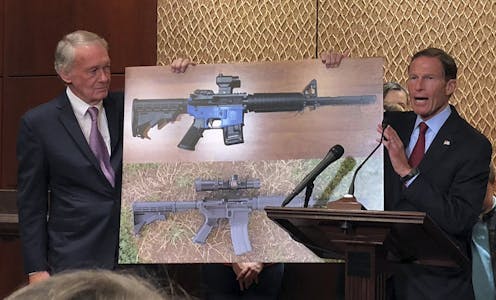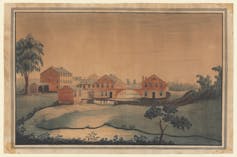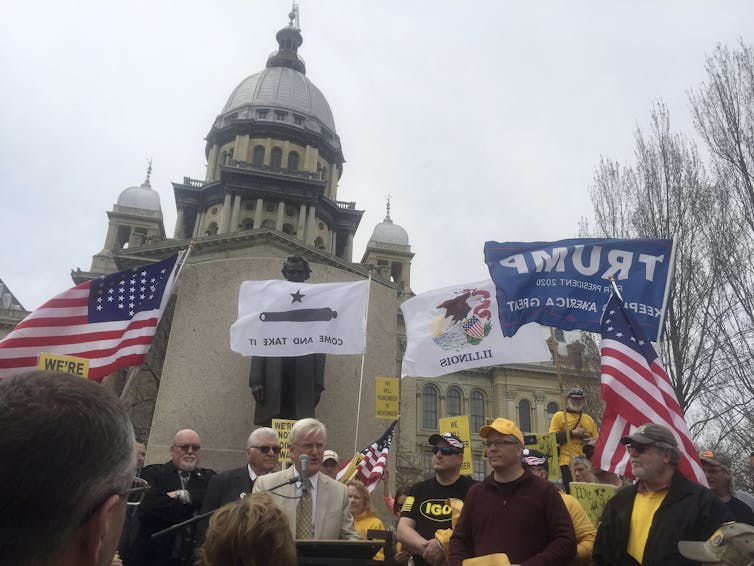Print-your-own gun debate ignores how the US government long provided and regulated firearms
A battle over the Second Amendment is exactly the wrong way to think about the government's role in the firearms industry.

The current debate over a Texas company’s “right” to allow anyone to download blueprints to its 3D-printed guns is following the same well-trodden terrain as every firearms fight for the past few decades: differing interpretations of the Second Amendment.
Cody Wilson, the founder of Defense Distributed and the creator of the first working plastic gun in 2013, argues it’s about every American’s right to bear arms. “I believe that I am championing the Second Amendment in the 21st century,” he told “CBS This Morning.”
On the other side are the federal judge who is temporarily blocking the release of the blueprints, the eight state attorneys general who sued Wilson’s company from putting the designs online and gun control advocates across the country who want the government to do more to regulate firearms.
This misses the point. Government regulation and the gun industry are not natural enemies. They have a historical synergy that long predates Supreme Court rulings on the constitutionality of gun control legislation. It was not until 1886 that the Supreme Court even addressed the federal government’s ability to regulate gun ownership. For most of the nation’s first century, the government perceived its constitutional duty as providing guns – not protecting an open-ended “right to bear arms.”
My research on the history of the government’s intervention in the arms industry suggests a return to its role as guarantor of the gun trade would allow it to do more to reduce gun violence and mass shootings without trampling on the Second Amendment.
Patron of the arms
Before the Second Amendment became the main weapon of gun rights advocates, there was Article 1, Section 8 of the U.S. Constitution.
That passage gave Congress the power to support armies and provide arms for the militia. Accordingly, the federal government subsidized and improved arms manufacturing and expanded the market for guns. It also carefully regulated the industry it helped create.

Following the American Revolution, government action was necessary to grow the number of firearms in the new nation because arms makers had little personal incentive to expand production for what was a relatively limited civilian market. Congress prohibited the export of arms and made their import mostly duty-free during the early 1790s. It also constructed two federal armories and began to invest in private gun factories to supplement the armories’ output.
These gun factories were located primarily in the Connecticut River Valley, where some of the biggest gun companies today such as Colt, Smith and Wesson and Sturm, Ruger & Co. have their roots. Five-year renewable contracts that came with 10 percent to 20 percent cash advances and purchasing agreements supported the establishment of such arms companies as Eli Whitney’s, from whose armory the legendary Samuel Colt would later borrow equipment.
Manufacturers’ letters and petitions to the federal government reveal how dependent they were on public support. In one such petition, an arms contractor wrote, “If the patronage of the government is not continued, our factories will be worth but little.”
Well regulated
But the government did not just subsidize the arms industry, it regulated it. The contracts it issued required that all firearms conform to federal standards and pass routine performance and safety inspections. Regular communication kept manufacturers and government officials on the same page.
Every time manufacturers finished an order, they notified the Ordnance Department (the federal bureau that oversaw small arms supply), which dispatched a federal inspector to test and stamp approved firearms. Although today’s gun rights advocates bemoan a 2007 California state law that mandates semi-automatic handguns be “micro-stamped,” 19th-century government stamps were symbols of quality and regularity.
And the government would not agree to purchase weapons from new contractors without testing them first.
When Samuel Colt, for example, solicited government patronage in the 1830s, a board of ordnance officers expressed concern that several features of his new revolvers caused safety risks, namely “the possibility of two or more chambers going off at the same time” and the “deafening sharpness … which must injure the hearing of those who use them.” They recommended more trials in the field.
Once Colt improved the revolvers, the U.S. military purchased them for use on the frontier and in the Mexican-American War in the mid-19th century. Battlefield testimony gave Colt a marketing boon in domestic civilian and international markets, and he and the other arms makers who got their start in this period – Christian Sharps, Smith and Wesson and Oliver Winchester – became the most iconic private arms suppliers of the United States and the world.
They benefited from a government that knew it had a responsibility to intervene in the firearms industry.

Moving the debate forward
Today the government no longer needs to grow the arms industry, but it does need to regulate it.
The way that the debate is currently framed creates a false set of oppositional outcomes: righteous self-protection versus vindictive regulation; public safety versus maniacal gun-wielding. These are not the only options.
Instead, gun rights advocates might think more about how the government has helped them. Federal regulations, after all, helped make the American arms industry the most technologically advanced in the world.
And for their part, policymakers could embrace their historical responsibility to regulate the industry. It used to be the norm for the government to test firearms for safety and hold manufacturers accountable for the weapons they made.
Meanwhile, Americans on all sides of the issue might talk more about what a closer relationship between the government and gun industry could mean for the future.
Compromise or no compromise, the outcome should not depend on what a given Supreme Court justice says about the Second Amendment.
Lindsay Schakenbach Regele does not work for, consult, own shares in or receive funding from any company or organization that would benefit from this article, and has disclosed no relevant affiliations beyond their academic appointment.
Read These Next
From truce in the trenches to cocktails at the consulate: How Christmas diplomacy seeks to exploit s
World leaders like to talk up peace at Christmastime. But alongside the tales of seasonal breaks in…
As DOJ begins to release Epstein files, his many victims deserve more attention than the powerful me
Powerful men connected to Jeffrey Epstein are named, dissected and speculated about. The survivors,…
How to reduce gift-giving stress with your kids – a child psychologist’s tips for making magic and a
Depending on family circumstances and a child’s personality type, gift giving runs the gamut of fun…






